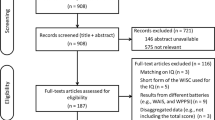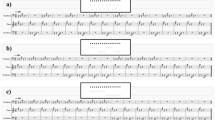Abstract
The EEG correlates of the verbal, numerical, and figural IQ components according to the power and coherence characteristics of the baseline EEG in six frequency bands were studied taking into account personality traits of subjects (extroversion, neuroticism, psychoticism, and anxiety). Analysis of variance and correlation showed that a decreased power of the low-frequency θ1, 2and α1 rhythms and increased EEG power in the β2 band with the right-hemispheric dominance were characteristic of persons with higher intelligence. These EEG characteristics were associated with increased interhemispheric interaction according to the coherence indices and increased coherence within the right hemisphere. Each of the intelligence components (verbal, numerical, and figural) was characterized by a specific baseline frequency–spatial EEG pattern distinguished by specific interactions, predominantly, between the frontal and caudal cortical regions in the θ and/or β2 frequency bands.
Similar content being viewed by others
REFERENCES
Razoumnikova, O.M., Features of the Spatial Organiza-tion of the EEG in Persons with Different Personality Characteristics, Zh. Vyssh. Nervn. Deyat. im. I.P. Pav-lova, 2000, vol. 50, no. 6, p. 921.
Rusalov, V.M., Rusalova, M.N., Kalashnikova, I.G., et al., Bioelectric Activity of the Human Brain in Repre-sentatives of Different Temperamental Types, Zh. Vyssh. Nervn. Deyat. im. I.P. Pavlova, 1993, vol. 43, no. 3, p. 530.
Sviderskaya, N.E. and Korol'kova, T.A., Influence of the Features of the Nervous System and Temperament on the EEG Spatial Organization, Zh. Vyssh. Nervn. Deyat. im. I.P. Pavlova, 1996, vol. 46, no. 5, p. 849.
Anokhin, A.P., Lutzenberger, W., and Birbauter, N., Spatiotemporal Organization of Brain Dynamics and Intelli-gence: An EEG Study in Adolescents, Int. J. Psycho-physiol., 1999, vol. 33, no. 3, p. 23.
Haier, R.J., Sigel, B.V., Tang, C.H., et al., Intelligence and Changes in Regional Cerebral Glucose Metabolic Rate Following Learning. Special Issue: Biology and Intelligence, Intelligence, 1992, vol. 16, no. 3, p. 415.
Jausovec, N. and Jausovec, K., Correlations between ERP Parameters and Intelligence: A Reconsideration, Biol. Psychol., 2000, vol. 55, no. 2, p. 137.
Neubauer, V., Freudenthaler, H.H., and Pfurtscheller, G., Intelligence and Spatiotemporal Patterns of Event-Related Desynchronization, Intelligence, 1995, vol. 3, no. 2, p. 249.
Kiroi, V.N., Voinov, V.B., and Vasil'eva, V.V., Electroen-cephalographic Correlates of Intelligence in Adoles-cents, Zh. Vyssh. Nervn. Deyat. im. I.P. Pavlova, 1995, vol. 45, no. 4, p. 669.
Jausovec, N. and Jausovec, K., Differences in Event-related and Induced Brain Oscillations in the Theta and Alpha Frequency Bands Related to Human Intelligence, Neurosci. Lett., 2000, vol. 293, no. 3, p. 191.
Bekhtereva, N.P., Bundzen, P.V., and Gogolitsyn, Yu.L., Mozgovye kody psikhicheskoi deyatel'nosti (Brain Codes of Mental Activity), Leningrad: Nauka, 1977.
Ivanitskii, A.M., Brain Substrate of Subjective Mental Experience: A Hypothesis of Informational Synthesis, Zh. Vyssh. Nervn. Deyat. im. I.P. Pavlova, 1996, vol. 46, no. 2, p. 241.
Deary, I.J. and Caryl, P.G., Neuroscience and Human Intelligence Differences, Trends Neurosci., 1997, vol. 20, no. 8, p. 365.
Pelosi, L., Holly, M., Slade, T., et al., Event-related Potential (ERP) Correlates of Performance of Intelli-gence Tests, Electroencephalogr. Clin. Neurophysiol., 1992, vol. 84, no. 6, p. 515.
Basar, E., Basar-Eroglu, N., Parnefijord, R., et al., Evoked Potentials: Ensembles of Brain Induced Rhyth-micities in the Alpha, Theta and Gamma Ranges, Induced Rhythms in the Brain, Basar, E. and Bullock, T.H., Eds., Boston: Birkhauser, 1992, p. 155.
Bosel, R., Mecklinger, A., and Stolpe, R., Changes in Spontaneous EEG Activity Indicate a Special Kind of Information Processing in Concept Learning, Biol. Psychol., 1990, vol. 31, no. 3, p. 257.
Sheppard, W.D. and Boyer, R.W., Pretrial EEG Coher-ence as a Predictor of Semantic Priming Effects, Brain Language, 1990, vol. 39, no. 1, p. 57.
Wszolek, Z.K., Herkes, G.K., Lagerlund, T.D., and Kokmen, E., Comparison of EEG Background Frequency Analysis, Psychological Test Scores, Short Test of Men-tal Status, and Quantitative SPECT in Dementia, J. Geri-atr. Psychiat. Neurol., 1992, vol. 5, no. 1, p. 22.
Hoptman, M.J. and Davidson, R.J., Baseline EEG Asymmetries and Performance on Neurophysiological Tasks, Neuropsychologia, 1998, vol. 36, no. 12, p. 1343.
Razoumnikova, O.M., Functional Organization of Dif-ferent Brain Areas during Convergent and Divergent Thinking: An EEG Investigation, Cogn. Brain. Res., 2000, vol. 10, no. 1-2, p. 11.
O'Boyle, M.W., Alexander, J.E., and Benbow, C.P., Enhanced Right Hemisphere Activation in the Mathe-matically Precocious: A Preliminary EEG Investigation, Brain Cognition, 1991, vol. 17, no. 2, p. 138.
Earle, J.B., Garcia-Dergay, P., Manniello, A., and Dowd, K., Mathematical Cognitive Style and Arithmetic Sign Comprehension: A Study of EEG Alpha and Theta Activity, Int. J. Psychophysiol., 1996, vol. 21, no. 1, p. 1.
Glass, A. and Riding, R.J., EEG Differences and Cogni-tive Style, Biol. Psychol., 1999, vol. 51, no. 1, p. 23.
Corsi-Cabrera, M., Arce, C., Ramos, J., and Guevara, M.A., Effect of Spatial Ability and Sex on Inter-and Intrahemispheric Correlation of EEG Activity, Electro-encephalogr. Clin. Neurophysiol., 1997, vol. 102, no. 1, p. 5.
Volf, N.V. and Razumnikova, O.M., Sex Differences in EEG Coherence during a Verbal Memory Task in Nor-mal Adults, Int. J. Psychophysiol., 1999, vol. 34, no. 2, p. 113.
Namazova, V.P. and Zhmyrikov, A.N., Psikhologo-peda-gogicheskie metody issledovaniya individual'no-lichnostnykh osobennostei (Psychological and Pedagogical Methods of Investigation of Individual Personality Characteristics), Moscow: Mosk. Gos. Univ., 1988.
Amthauer, R., Intelligence-Structure-Test, 4th ed., Göt-tingen: Hogrefe, 1970.
Eysenck, G., Pakula, A., and Goshtautas, A., Standardization of Eysenck Personality Questionnaire for Adult Population of Lithuania, Psikhol. Zh., 1991, no. 12, p. 83.
Spilberger, C.D., Gorsuch, R.L., and Lushene, R.E., Manual for the State-Trait Anxiety Inventory, Palo Alto, CA: Consulting Psychological, 1970.
Petsche, H., Approaches to Verbal, Visual and Musical Creativity by EEG Coherence Analysis, Int. J. Psycho-physiol., 1996, vol. 24, no. 1-2, p. 145.
Rappelsberger, P. and Petsche, H., Probability Mapping: Power and Coherence Analysis of Cognitive Processes, Brain Topogr., 1988, vol. 1, no. 1, p. 46.
Klimesch, W., Pfurtscheller, G., Mohl, W., and Schimke, H., Event-related Desynchronization. ERD-Mapping and Hemispheric Differences for Words and Numbers, Int. J. Psychophysiol., 1990, vol. 8, no. 3, p. 297.
Simos, P.G., Breier, J.I., Zouridakis, G., and Papanicolaou, A.C., Identification of Language-specific Brain Activity Using Magnetoencephalography, J. Clin. Exp. Neuropsychol., 1998, vol. 20, no. 5, p. 706.
Smith, M.E., McEvoy, L.K., and Gevins, A., Neuropsy-chological Indices of Strategy Development and Skill Acquisition, Cogn. Brain Res., 1999, vol. 7, no. 3, p. 389.
Meyer-Lindenberg, A., Bauer, U., Kriger, S., et al., The Topography of Non-linear Cortical Dynamics at Rest, in Mental Calculation and Moving Shape Perception, Brain Topogr., 1998, vol. 10, no. 4, p. 291.
Inouyer, T., Shinosaki, K., Iyama, A., and Matsumoyo, Y., Localization of Activated Areas and Directional EEG Patterns during Mental Arithmetic, Electroencephalogr. Clin. Neurophysiol., 1993, vol. 86, no. 4, p. 224.
Sasaki, K., Tsujimoto, T., Nambu, A., et al., Dynamic Activities of the Frontal Association Cortex in Calculat-ing and Thinking, Neurosci. Res., 1994, vol. 19, no. 2, p. 229.
Dahaene, S., Tzourio, N., Frak, V., et al., Cerebral Activation during Number Multiplication and Comparison: A PET Study, Neurophysiology, 1996, vol. 34, no. 11, p. 1097.
Pulvermuller, F., Birbaumer, N., Lutzenberger, W., and Mohr, B., High-frequency Brain Activity: Its Possible.626 Role in Attention, Perception and Language Processing, Progr. Neurobiol., 1997, vol. 52, no. 5, p. 427.
Inanaga, K., Frontal Midline Theta Rhythm and Mental Activity, Psychiat. Clin. Neurosci., 1998, vol. 52, no. 6, p. 555.
Klimesch, W., Memory Processes, Brain Oscillations and EEG Synchronization, Int. J. Psychophysiol., 1996, vol. 24, no. 1-2, p. 61.
Michel, C.M., Henggeler, B., Brandels, D., and Lehmann, D., Localization of Sources of Brain Alpha/Theta/Delta Activity and the Influence of the Mode of Spontaneous Mention, Physiol. Measurement, 1993, vol. 14, suppl. 4A, p. A21.
Shinomiya, S., Urakami, Y., Nagata, K., et al., Frontal Midline Theta Rhythm: Differentiating the Physiological Theta Rhythm from the Abnormal Discharge, Clin. Electroencephalogr., 1994, vol. 25, no. 1, p. 30.
von Stein, A. and Sarnthein, J., Different Frequencies for Different Scales of Cortical Integration: From Local Gamma to Long Range Alpha/Theta Synchronization, Int. J. Psychophysiol., 2000, vol. 38, no. 3, p. 301.
Krause, C.M., Viemero, V., Rosenqvist, A., et al., Relative Electroencephalographic Desynchronization and Synchronization in Humans to Emotional Film Content: An Analysis of the 4-6, 6-8, 8-10 and 10-12 Hz Fre-quency Bands, Neurosci. Lett., 2000, vol. 286, no. 1, p. 9.
Author information
Authors and Affiliations
Rights and permissions
About this article
Cite this article
Razoumnikova, O.M. Reflection of the Intelligence Structure in the Spatiotemporal Features of the Baseline EEG. Human Physiology 29, 619–626 (2003). https://doi.org/10.1023/A:1025876203177
Issue Date:
DOI: https://doi.org/10.1023/A:1025876203177




